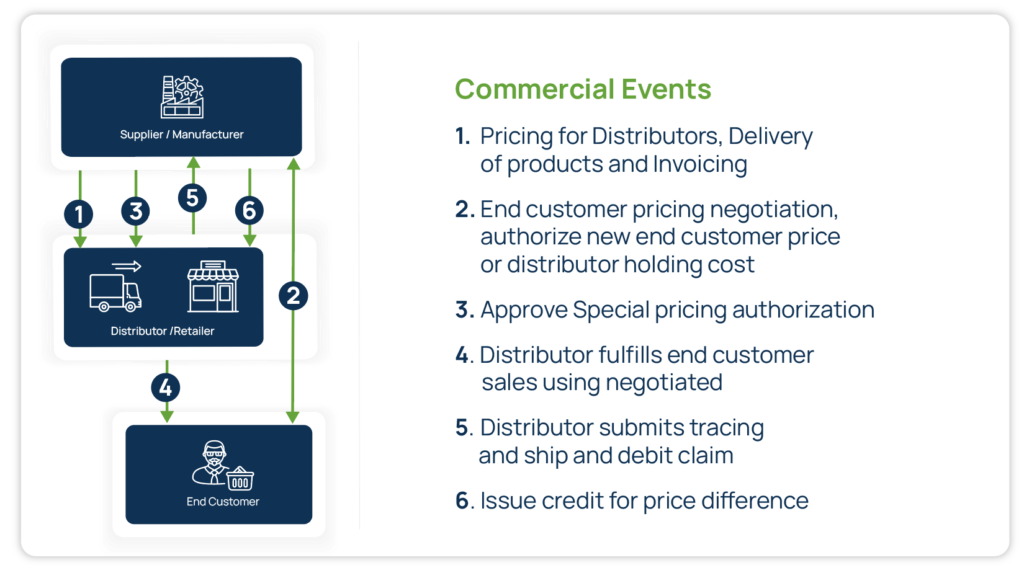
Do you sell through distribution but negotiate special end-customer pricing that then results in a difference payment to your distributor? Is there a difference between the special end-customer price and the distributor’s standard into stock price? If your answer to these questions is yes, this best practice discussion is for you.
What are SPAs?
There are many different names for special pricing agreement programs. You might have heard of these:
- SPA Process – short form for Special Price Agreement, this is probably the most common
- S&D – short for “Ship & Debit” and common in high tech
- POD – short for Proof of Delivery / Price on Delivery and common in consumer-packaged goods and packaging
- Chargebacks – common in medtech
- Billbacks – common in wholesale distribution
- CUPS – short for Credit Upon Proof of Sale
- Supported Price Process

Common SPA Process Flow

A manufacturer has an established standard price that is common across all distributors, or they have a specific negotiated “into-stock” price for each distributor. Products are delivered into the distribution channel at this standard pricing.
- A sales organization negotiates an end-customer price for the purchase of an item. The sales organization might be a manufacturer direct sales team, a distributor sales team, or a third party sales agent. If the end-customer price is less than the standard or into-stock price for the distributor, a payment from the manufacturer will fund the difference between stock price and supported end-customer price.
- The delivery to the end customer is coordinated through the distributor, and often is fulfilled out of in-stock inventory at the distributor.
- The distributor prepares proof-of-delivery / sales data in a claim submitted to the manufacturer to detail the agreed upon price and quantities. A claim for the difference between stock price and supported price is tracked as due to the distributor.
- The manufacturer receives the claim & sales data, validates the detail, and pays the distributor the difference between stock price and supported end customer price.
SPA Process Challenges
SPA processes can be challenging for both the manufacturer and the distributor. Most often, difficulties arise when tracking information related to the negotiated customer price, the product sale and delivery, the financial accruals (accounting for credit due), and payment. Discrepancies can impact either the manufacturer, the distributor, or both.
- Tracking, approving, and selling at the agreed upon end-customer price (all parties)
- Tracking distributor stock price detail (all parties)
- Preparing a claim for SPA credit (distributor)
- Receipt and validation of claims for SPA credit (manufacturer)
- Financial tracking of payment for SPA credit (all parties)
Revenue Accounting Processes for Commercial Events
In the world of commercial events, proper revenue accounting is critical to ensuring accurate financial reporting and maximizing profitability. Here is the typical flow per commercial event:
Commercial Event: Pricing for Distributors, Delivery of Products & Invoicing
The revenue accounting process for commercial events involving pricing for distributors, delivery of products, and invoicing is complex and requires careful consideration of several factors. One key factor is end customer pricing negotiation, which can influence pricing for distributors and distributor holding costs. In this scenario, manufacturers typically invoice distributors for stock products, but the revenue recognition options can vary. One option is to allocate a portion of revenue as deferred COGS to reduce revenue for estimated S&D credits, factoring in any special pricing provided to distributors. Another option is to defer the entire revenue until proof of sales is received from the distributor. Both options have their advantages and drawbacks, and companies must carefully consider their revenue accounting approach to ensure accurate financial reporting and maximize profitability.
Commercial Event: Special Pricing Authorization
For commercial events that involve special pricing authorization, revenue accounting involves the supplier reviewing and approving the price impact and adjusting their accounting processes accordingly for accurate financial reporting.
Commercial Event: Distributor Fulfills End Customer Sales Using Negotiated Pricing
When a distributor fulfills end customer sales using negotiated pricing, revenue accounting can be driven by either the approved price at which the distributor sells to the end customer or the expected rebate, which is the difference between the distributor’s buy and contract price. Accruing for expected rebate is a common revenue recognition option in this scenario. By accounting for these pricing factors, companies can ensure accurate financial reporting and maximize their profitability.
Commercial Event: Distributor Submits Tracing and Ship and Debit Claim
When a commercial event involves a distributor submitting tracing and ship and debit (S&D) claims, revenue accounting requires the seller to validate the tracing data and S&D claim before actualizing the posting to COGS or deferred revenue. If the entire revenue has been deferred, revenue can be recognized for the units sold by the distributor. In this scenario, actualizing the posting to COGS from deferral is a crucial step in ensuring accurate financial reporting and maximizing profitability. By carefully managing the revenue accounting process for distributor tracing and S&D claims, companies can make informed financial decisions and optimize their revenue streams.
Commercial Event: Issue Credit for Price Difference
When a commercial event involves issuing credit for a price difference, revenue accounting requires the issuance of credit to the distributor for the approved claim amounts and the reduction of their receivables. This process is critical to ensuring accurate financial reporting and maintaining good relationships with distributors. By properly managing the revenue accounting process for credit issuance events, companies can optimize their revenue streams and minimize the risk of financial discrepancies.
Streamline your SPA Pricing Processes
At Vendavo, we have substantial experience delivering technology solutions for pricing and commercial process and we’ve supported SPA pricing processes for both manufacturers and distributors since the company began more than 20 years ago. Through this lens, we’ve assembled best practices for automating your SPA processes from initial negotiation to final accounting.
Best Practices: Negotiation
Implement a centralized, common digital process for evaluating SPA price decisions
Your system should track and evaluate customer special prices requests consistently. Look for one that:
- Centralizes all the SPA pricing agreements / contract pricing agreements
- Establishes a unique identifier that can be used by manufacturers and distributors to track approved pricing through to order execution & accounting
- Provides a clear evaluation of end-customer price decision with contextual metrics (supporting analytics, target price guidance for end-customer, revenue & margin metrics)
- Offers visibility for all parties into distributor stock pricing and supported price credit due to distributor for the customer order
- Embeds price & approval policies and workflows for price decisions
- Has the ability to track approved pricing and price requests and coordinate sales between the manufacturer and distributor partner
- Generates any accruals required to support sales through to fulfillment and ultimate rebate issuance to distributor
An automated SPA system will track and evaluate customer special price requests consistently and save you time and money along the way.
Offer a self-service, digital price request process for distributor partners
In distributor-led sales opportunities, a best practice is supporting your distributor partners with a digital process by which they can submit (and manufacturers can evaluate) requests for pricing below standard price.
Distributors should be able to select products, understand their stock price, define the supported price requested for the customer and evaluate the credit due from the manufacturer.
Best Practices: Customer & Accounting Execution
Deploy a proper process for distributor accrual for rebate impact.
For distributor-side accounting, automate the tracking of a SPA order / delivery. Include:
- Clear reference and tracking to approved SPA price (reference ID) and full awareness of the rebate due (the difference between stock price and supported customer sale price)
- Tagging of transaction detail with SPA ID to support rebate claim preparation
- Automated revenue accrual to account for rebate (& impact to net price and revenue for income reporting)
Include a process for distributor rebate claim submission
Distributors should have capabilities and automation to quickly package proof-of-sale detail to submit for SPA pricing rebate credit from the manufacturer. If the manufacturer has defined a recommended format for this data submission, adhering to their standard will expedite the receipt of your earned rebate.
It’s best to have a central system to track claims that have been submitted for status. If the manufacturing partner permits it, think about invoice payment deductions to manage cash associated with expected net price & revenue realization. Lastly, a best practice for distributors includes reporting to understand the volume of SPA deals, pricing decisions, and the status of deals and claims across the business and if relevant, the manufacturer partners with whom they work.
Manufactures should offer a consistent claim receipt & validation process
Managing claim submissions, claim validation, and payments with the distributor channel can require significant effort. Manufacturer best practices for the SPA proof-of-sale claims process includes:
- Provide distributor partners with a consistent data format/template expectation for the receipt and process of SPA claims
- Ideally, support the ability for distributors to provide claim submissions digitally
- Establish a rigorous claim validation process that confirms: Reference SPA Pricing Deal ID, Customer, approved supported price and product eligibility, confirmation of SPA rebate amount (different between stock and supported price) confirmation of date range, sanity on checks for sales data vs channel inventory shipments
- If a short-pay or deduction has taken place, automation in the approval & payment to the distributor with an ability to resolve and retire specific deductions is ideal
- If an accrual took place at the time of SPA approval or sale, the automated retirement of that accrual against stock price as part of the payment process
- Communicate to distributor partners on the status of submitted claims through the duration of the receipt-validation-payment process
Rebate management programs can be a substantial competitive differentiator and play an important role in your overall pricing strategy. Typically, employing rebate programs can drive 2-10% incremental sales vs not having a rebate system in place.
To proactively design and manage your rebate programs across channels, check out Vendavo Rebate & Channel Manager
Don’t forget to include a measurement process for SPA program performance and efficacy
Manufactures need implement capabilities for assessing the effectiveness of their SPA pricing process and assess end-customer pricing decisions across the distribution channel. This includes broad visibility to net price and net margin inclusive of these rebates.
Stay Competitive with Vendavo
To manage end-customer pricing and maintain competitiveness in active markets, SPA pricing programs can be very valuable tools for manufacturers who sell through distribution. Despite the value of these programs, they can be laborious programs to manage from an execution and accounting standpoint.
Vendavo offers end-to-end process support solutions that include all aspects of the best practices discussed in this overview. Learn more about Rebate & Channel Manager.
